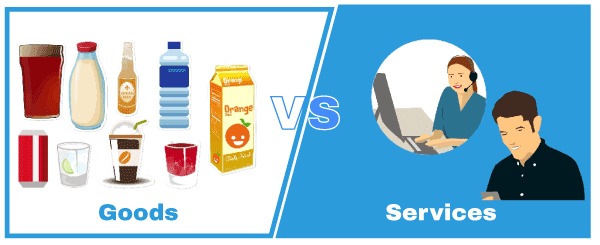Difference between Goods and ServicesGoods and services both are economic concepts. We have to pay for both of them. Good are the things like pens, books, television, etc. However, services are the activities like watching a movie in a multiplex, travelling by air, etc. They are described below including the major differences between them. 
GoodsGoods are things that satisfy user needs and want. They are tangible which means you can touch and see the goods. For example refrigerator, TV. So, it is possible to store the goods for the future. Goods can be separated from their owner. Like 'x' person is making goods and 'y' person is selling goods. Here goods are separated from his maker. It is a physical object like a car, fan. A particular good remains that same such as Colgate tooth paste will be same in all stores. It cannot varies from shop to shop that is why it is of homogeneous type. The ownership of goods can be transferred to another person. The owner is changed in this. Furthermore, there is a time interval between production and utilization of goods. Goods are classified into free goods and economic goods. Free goods: Free goods are obtained from nature, or it's nature's gift. They do not have the price, and there is no cost of production. These goods are useful but do not take anything in exchange because their value cannot be specified, for example, air, sea, water, etc. Economic goods: These goods are man-made goods. These goods have a price. For producing these goods, money is required. These goods are useful and take money in exchange. Their value is included in national income. Types of goods1. Final goods: They are the goods that are ready for use by their user, and their production process is completed, and no value is remaining to be added to goods. These services are included in the price of national income. Final goods are ready to use by customers or consumers, which are of following two types;
2. Intermediate goods: They are goods that have not crossed the boundary line of production. The work of adding value to these goods is remaining. It is not ready for use by the final user. We can say that the good is not ready to be sold to the customer. These goods are purchased by one firm from other firms. It is purchased by the producer as raw material and also purchased by the producer for the purpose of reselling. Besides this, the expenditure on intermediate goods by the producer is called intermediate cost. 3. Existing goods: These goods are present physically. It is split into two parts.
5. Future goods: Future goods are not yet in existence. These goods are in the manufacturing process now. Their manufacturing will be completed in the future. ServicesServices are activities that fulfil user requirements. Services are intangible means you cannot touch and see service. For example, a person went to the doctor, the doctor gave treatment to the person, but the person cannot see or touch that treatment. Similarly, you enjoy and entertained while watching a movie, but you cannot touch or see the entrainment rather you can only experience it. So, these activities are called services. It is not possible to store the service for the future. Service and service providers cannot be apart from each other. Services do not have similarities, and the service varies according to the service provider. That's why it is of heterogeneous type. The ownership of services cannot be transferred to another person. The owner is not changed in this. There is no time gap between production and consumption in services. Types of service
Features of Services
Difference between goods and services
Next TopicDifference between
|
 For Videos Join Our Youtube Channel: Join Now
For Videos Join Our Youtube Channel: Join Now
Feedback
- Send your Feedback to [email protected]
Help Others, Please Share










